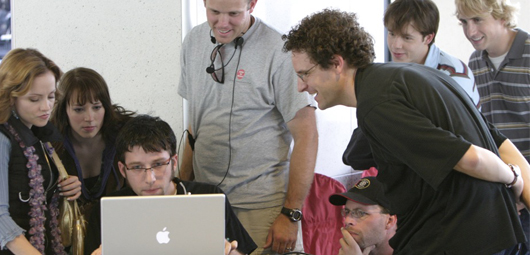Light, Camera, Action, iPod & MacBook: Your New Film Dailies

As film-makers know, one of the most difficult technical matters during the shoot are the dailies. Dailies are the footage that you shot that day – you want to view them to make sure you got what you needed performance wise and story tellng wise but also that you have enough coverage shots (long, medium, closeups, reverses). Back in the old, old days, when everyone shot on film, that film had to be developed, processed, edited and then viewed. That’s why in the “old” days, the director had to say after saying “Cut,” they would add “That’s a print,” or “Print that,” which meant it was “good enough” to take the time and money it cost to develop and manually splice together to make a daily/viewing print. The rest was developed but just stored. Most directors shoot at about a 1 to 8 or 1 to 12 ratio of useable footage versus footage filed away in some salt mine. Scary directors like Warren Beatty have been known to shoot 1 to 85 ratio … anyway, this was one reason studios wanted to shoot everything on the lot – much easier to not only develop the film for dailies but also because the could see what was going on … and fire you. Directors on some remote location used to be out of their immediate control and even today, you have lowly PA’s who’s job it is to schlep the cannisters of film back to “Hollywood.” Advice to novice directors, NEVER shoot the opening and close of your film early on and shoot a big action scene first. Why? a) so the suits can’t fire you because they have no opening or close of the film yet and b) they become worried if the only footage they can see is two guys talking and opening doors.
Anyway, fast forward to 2007 and the iPod has become the portable dailies machine – and in some senses, even more instant …
“The director and assistant editor of the upcoming film “Together Again for the First Time” explain how they used an iPod and Final Cut Pro for video playback during production of the indie feature. While not achieving TRUE dailies, their new-found continuity tool Did change the entire creative process.
The Problem
Last spring, as we began pre-production on the film, we discussed our approach for video playback. Because films are created one shot at a time, scenes are most often shot over several days or weeks. Having a reliable system for playing back the previous shots is critical for continuity in performance, art direction, camera movement and angles, and so on. It’s also a given if we want to create the illusion of a seamless reality and give the story a chance to engage the audience on its own terms.
On previous projects we’ve recorded shots from the camera’s video tap to VHS, Hi-8 or MiniDV cassettes. However, with each shooting day, the number of cassettes grows. On Together Again, our shooting ratio was roughly 15:1, which would have amounted to approximately 25 one-hour tapes. Also, like most productions, we shot Together Again out of sequence. It took precious production time, which we came to view as lost production time, to find the appropriate tape and specific scene whenever we needed a shot from a previous shooting day. On top of this, the video playback area, known as “video village,” was located away from the set; we knew that running between the actors and video village would have affected shooting times and performance spontaneity. There had to be a better way.”
From & read rest at StudioDaily.com:
Of course they’re not the first, Peter Jackson also used the iPod to view special effects dailies … including one time where the guy carrying the iPod sensed trouble brewing and decided to he needed to run …







